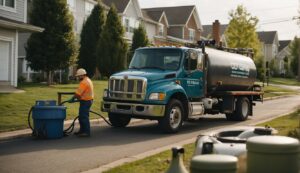Cesspool service is essential for the maintenance and proper functioning of a cesspool, a type of underground container for the temporary collection and processing of waste. Unlike septic systems, cesspools do not have a leach field for processing effluent, which means they must be maintained differently to prevent issues such as overflows and groundwater contamination. Regular service ensures that your cesspool operates efficiently, reducing the risk of environmental damage and costly repairs.

Proper maintenance involves regular inspections and pumping to remove the build-up of solids and prevent the cesspool from overflowing. It’s important to work with a certified service provider to ensure compliance with local regulations and environmental guidelines. Moreover, understanding the different types of cesspools can help you determine the specific service needs of your system, as factors like size, age, and design can influence maintenance requirements.
Key Takeaways
- Regular cesspool service prevents overflows and protects the environment.
- Certified providers ensure regulatory compliance and system efficiency.
- Understanding your cesspool type helps tailor maintenance needs.
Understanding Cesspool Services
When you require cesspool services, it is essential to know what is involved. Cesspool maintenance is critical to ensure proper function and to prevent environmental contamination.
Regular Inspections:
- Frequency: At least once every few years, depending on usage.
- Purpose: To determine sludge levels and structural integrity.
Pumping Services:
- Timing: Typically needed every 3 to 5 years.
- Indicators: Slow drainage, foul odors, or wastewater backup.
Emergency Services:
- Response: Quick action is needed for overflow or leakage.
- Signs: Sudden lawn wetness or sewage exposure.
Installation and Repair:
- New Installations: When constructing a new property or replacing a failing system.
- Repairs: Crack sealing, lid replacement, and baffle fixes to extend service life.
Your choice of a service provider should be based on their experience, certification, and adherence to local regulations. Remember to verify that the service provider you choose is licensed and insured, assuring accountability and expertise in the maintenance of your cesspool system.
Types of Cesspools

Cesspools come in various materials, each with specific characteristics regarding durability and maintenance. Selecting the right type depends on your location, soil conditions, and regulations.
Concrete Cesspools
Concrete cesspools are long-lasting and durable, offering a life expectancy upwards of 20-30 years with proper maintenance. However, they are susceptible to cracks and leaks due to soil movement or root intrusion.
- Pros: High durability, strong structure
- Cons: Heavy (difficult to install), susceptible to cracking
Fiberglass Cesspools
Fiberglass cesspools are lightweight and corrosion-resistant, making them a popular choice. They are easier to install than concrete due to their lower weight.
- Pros: Corrosion-resistant, easy installation
- Cons: Less structural strength compared to concrete
Plastic Cesspools
Plastic cesspools, typically made from polyethylene, offer a modern solution with resistance to corrosion and chemical damage. Lightweight and easy to install, they are suitable for a variety of soil types.
- Pros: Very lightweight, highly corrosion-resistant
- Cons: Can be more prone to damage from heavy soil pressure
Maintenance of Cesspools
Proper maintenance is crucial for the effective operation of your cesspool. It helps in preventing backups, maintaining drainage efficiency, and prolonging the system’s lifespan.
Regular Inspection
You should schedule annual inspections to assess the health of your cesspool. A professional can evaluate the levels of solids, potential clogs, and integrity of the walls. The checklist includes:
- Structural Condition: Checking for cracks or collapses.
- Sludge Levels: Measuring solid waste accumulation.
- Effluent Filtration: Ensuring clear outflow of liquid.
Pumping Services
Pumping must occur once the sludge and scum occupy a third of the cesspool’s volume. This typically is needed every three to five years, but may vary based on usage.
- Frequency: Monitor and record pump-outs to anticipate future service.
- Capacity: Use a professional service that properly disposes of waste according to local regulations.
Chemical Treatments
Chemical treatments are sometimes used to break down waste. However, use them sparingly and according to guidelines, as they can:
- Disrupt the Bacteria: Necessary bacteria can be harmed, impairing waste decomposition.
- Contaminate Groundwater: Harmful chemicals might leach into your water supply.
Cesspool Aeration
Aeration can improve waste breakdown by introducing oxygen, and involves:
- Technique: Inserting tubes to circulate air at the bottom of the cesspool.
- Professional Assessment: Determining if aeration is suitable for your cesspool’s size and condition.
Cesspool Service Procedures
Cesspool service is critical for maintaining your system’s efficiency and longevity. Here, you will learn the essential steps involved in servicing your cesspool.
Inspection and Assessment
Initially, a thorough inspection is conducted to determine the cesspool’s condition. This includes checking for signs of backup, leakage, and damage. Assessments often involve:
- Visual checks: Evaluation of the area surrounding the cesspool for abnormal wetness or foul odors.
- Level monitoring: Measurement of sludge and scum layers using special tools to decide if pumping is necessary.
Pumping and Cleaning
Your cesspool requires regular pumping to remove solids and prevent overflows. The process includes:
- Pumping: A vacuum truck extracts the waste, which is then properly disposed of.
- Cleaning: High-pressure water jets may clean the walls and piping, ensuring unobstructed flow.
Repair and Maintenance
Ongoing maintenance avoids costly repairs and extends your cesspool’s lifespan. Key maintenance activities are:
- Regular inspections to identify issues early.
- Root removal: Roots invading the cesspool are cut and removed as they can cause blockages or damage.
Installation and Replacement
If your cesspool can no longer be serviced effectively, installation or replacement is the next step. This involves:
- Site preparation: Excavating the area while considering local regulations.
- Cesspool installation: Setting up a new cesspool system, which includes laying pipes and constructing the holding tank.
Environmental Concerns
When considering cesspool services, it’s crucial to understand their environmental implications. Proper management is essential to mitigate the risk to soil quality, prevent water contamination, and control odors.
Impact on Soil
You might not realize it, but a poorly maintained cesspool can significantly damage soil health. Leaks from cesspools can:
- Introduce harmful chemicals into the soil.
- Disrupt the natural balance of soil microbes.
It’s vital to ensure the structure’s integrity to protect the surrounding soil ecosystem.
Water Contamination
Cesspools, if not managed correctly, pose a serious risk to water sources. Here’s how:
- Nutrients like nitrogen and phosphorus can leach into groundwater, leading to eutrophication.
- Pathogens from human waste can spread, potentially affecting drinking water.
Routine maintenance is critical to safeguard your local water supplies from these pollutants.
Odor Control
Managing odors is a significant environmental concern associated with cesspools:
- Foul smells can indicate an overfilled or failing system.
- Regular servicing is required to minimize the release of noxious gases like hydrogen sulfide and methane.
This not only improves air quality but also ensures community well-being.
Regulatory Compliance

When servicing cesspools, adherence to regulatory compliance is essential for legal operation and environmental protection.
Local Regulations
In your area, local health departments typically govern cesspool maintenance standards. You must familiarize yourself with specific Local Codes and Zoning Restrictions to ensure compliance. Failure to adhere may result in fines or cessation of services.
Permit Requirements
Before beginning any cesspool servicing, confirm you have the necessary permits. These often include:
- Construction Permit: For new installations or major repairs.
- Operating Permit: Required for ongoing use and may be subject to renewal.
Ensure all paperwork is accurately completed and timely submitted.
Environmental Standards
Strict adherence to Environmental Standards is critical to prevent contamination of water sources. You are typically required to follow guidelines for:
- Effluent Limits: Maximum permissible levels of contaminants.
- Waste Handling: Proper processing and disposal methods.
Regular monitoring and reporting of your cesspool’s impact may also be mandatory.
Choosing a Cesspool Service Provider

Selecting the right cesspool service provider is crucial for maintaining your septic system’s health and efficiency. Consider the provider’s experience, range of services, reputation for customer satisfaction, and their pricing structure.
Experience and Expertise
When assessing providers, look for ones with a proven history in the industry. An established company with several years of experience is more likely to have dealt with a range of cesspool issues. Ensure they have licensed professionals who are trained and knowledgeable about local regulations.
Service Offerings
Your cesspool service provider should offer a comprehensive list of services. Essential services include:
- Inspections: Regular assessments to check for potential problems.
- Maintenance: Routine services to keep systems functioning correctly.
- Repairs: Addressing issues as they arise to prevent more significant damages.
- Installation: Replacement or new setups if your system cannot be repaired.
Customer Satisfaction
Look at customer reviews and testimonials to gauge satisfaction levels. A company that consistently receives positive feedback is likely reliable. Pay attention to how the company handles any negative reviews or complaints; it’s a good indicator of their dedication to customer service.
Pricing and Quotes
Transparent pricing is important in choosing a provider. Ask for detailed quotes that itemize costs for services offered. Be wary of providers who are hesitant to give you a quote or avoid providing a detailed breakdown. Comparing quotes from different companies can help ensure you receive fair pricing for the services you need.
Frequently Asked Questions
In this section, you’ll find concise answers to common inquiries about cesspool service, ensuring you can maintain your system effectively and understand the costs and considerations involved.
How often should a cesspool be serviced to maintain proper function?
Servicing your cesspool regularly is vital for its longevity. You should have it inspected annually and pumped every three to five years, depending on usage and size.
What are the typical costs involved in cesspool maintenance?
The cost for cesspool maintenance varies depending on location, size, and condition of the system. Typically, inspection costs range from $100 to $300, while pumping may cost between $200 to $400.
What are the signs that a cesspool requires immediate attention?
If you notice foul odors, sewage backups, pooling water around the cesspool area, or unusually lush vegetation near the pool, it’s time for immediate professional service.
How does one properly manage a cesspool to ensure environmental safety?
Proper management includes reducing water usage to avoid overflow, avoiding flushing harmful chemicals, and regular maintenance checks to prevent leakage or contamination of surrounding soil and groundwater.
What are the main differences between cesspools and septic tanks?
Cesspools are older systems that merely collect wastewater, whereas septic tanks have a design that facilitates treatment and separation of solids from liquids before the effluent is dispersed.
What factors affect the duration it takes for a cesspool to reach full capacity?
Factors include the size of the cesspool, the number of people using the system, the amount of wastewater generated, and whether solids are effectively broken down. More usage generally means faster capacity reach.









